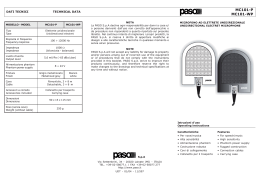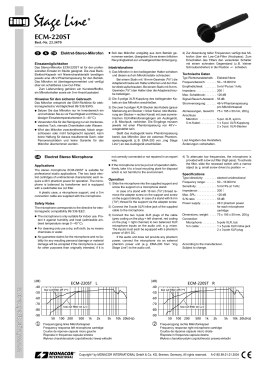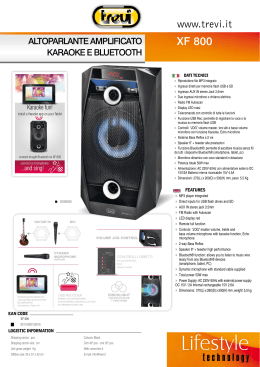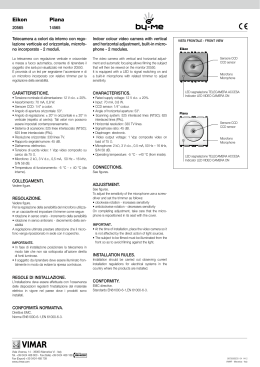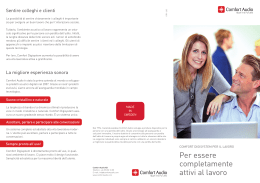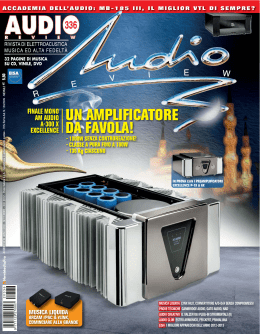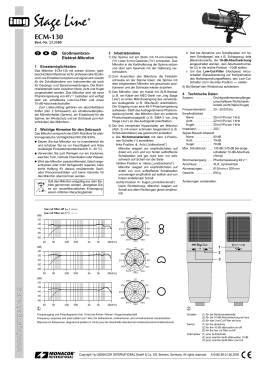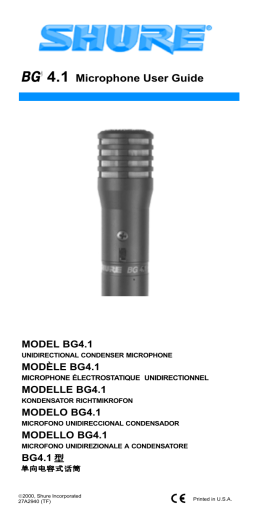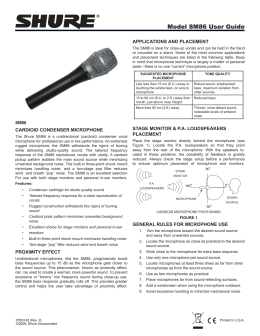HSE-72 Bestellnummer 23.6410 ELECTRONICS FOR SPECIALISTS ELECTRONICS FOR SPECIALISTS ELECTRONICS FOR SPECIALISTS ELECTRONICS FOR SPECIALISTS ELECTRONICS FOR SPECIALISTS ELECTRONICS FOR SPECIALISTS ELECTRONICS FOR SPECIALISTS D A CH Kopfbügelmikrofon GB Headband Microphone F B CH Microphone serre-tête Bitte lesen Sie diese Bedienungsanleitung vor dem Betrieb gründlich durch und heben Sie sie für ein späteres Nachlesen auf. Please read these operating instructions carefully prior to operation and keep them for later use. Veuillez lire la présente notice avec attention avant le fonctionnement et conservez-la pour pouvoir vous y reporter ultérieurement. 1 Einsatzmöglichkeiten 1 Applications 1 Possibilités dʼutilisation Dieses Kopfbügelmikrofon ist für den Betrieb mit einem Taschensender eines drahtlosen Audio-Übertragungssystems vorgesehen (z. B. ein Taschensender TXS-...HSE mit 3-poligem Mini-XLR-Anschluss von „img Stage Line“). Es eignet sich damit optimal für Gesangs- und Sprachanwendungen, die viel Bewegungsfreiheit erfordern, z. B. auf der Bühne. Alternativ zum Betrieb mit einem Taschensender lässt sich das Mikrofon auch über einen Speiseadapter (z. B. EMA-1 von „img Stage Line“), der die Mikrofonversorgungsspannung bereitstellt, mit einem Audiogerät, z. B. Mischpult, verbinden. This headband microphone is designed to be used in combination with a pocket transmitter of a wireless audio transmission system (e. g. pocket transmitter TXS-…HSE with 3-pole mini XLR connection from “img Stage Line”). It is ideally suited for vocal sound and speech applications that require much freedom of movement, e. g. on stage. As an alternative to the operation with a pocket transmitter, the microphone may be connected to an audio unit, e. g. mixer, by means of a power supply adapter (e. g. EMA-1 from “img Stage Line”) that provides the microphone with power. Ce microphone serre-tête est conçu pour un fonctionnement avec un émetteur de poche dʼun système de transmission audio sans fil (p. ex. un émetteur de poche TXS…HSE avec mini XLR 3 pôles de “img Stage Line”). Il est ainsi adapté pour des applications de chant et de discours où une grande liberté de mouvements est nécessaire, p. ex. sur scène. A la place du fonctionnement avec un émetteur de poche, le microphone peut être relié à un appareil audio, p. ex. table de mixage, via un adaptateur dʼalimentation (p. ex. EMA-1 de “img Stage Line”) qui met à disposition lʼalimentation pour le microphone. 2 Wichtige Hinweise für den Gebrauch 2 Important Notes 2 Conseils importants dʼutilisation Das Mikrofon entspricht allen relevanten Richtlinien der EU und ist deshalb mit gekennzeichnet. G Das Mikrofon ist nur zur Verwendung im Innenbereich geeignet. Schützen Sie es vor Feuchtigkeit und Hitze (zulässiger Einsatztemperaturbereich 0 – 40 °C). G Verwenden Sie für die Reinigung nur ein trockenes, weiches Tuch, niemals Chemikalien oder Wasser. G Wird das Mikrofon zweckentfremdet, falsch angeschlossen oder nicht fachgerecht repariert, kann keine Haftung für daraus resultierende Sach- oder Personenschäden und keine Garantie für das Mikrofon übernommen werden. The microphone corresponds to all relevant directives of the EU and is therefore marked with . G The microphone is suitable for indoor use only. Protect it against humidity and heat (admissible ambient temperature range: 0 – 40 °C). G For cleaning only use a dry, soft cloth; never use water or chemicals. G No guarantee claims for the microphone and no liability for any resulting personal damage or material damage will be accepted if the microphone is used for other purposes than originally intended, if it is not correctly connected, or if it is not repaired in an expert way. Le microphone répond à toutes les directives nécessaires de lʼUnion européenne et porte donc le symbole . G Le microphone nʼest conçu que pour une utilisation en intérieur. Protégez-le de lʼhumidité et de la chaleur (température ambiante admissible 0 – 40 °C). G Pour le nettoyage, utilisez un chiffon sec et doux, en aucun cas de produits chimiques ou dʼeau. G Nous déclinons toute responsabilité en cas de dommages corporels ou matériels résultants si le microphone est utilisé dans un but autre que celui pour lequel il a été conçu, sʼil nʼest pas correctement branché ou réparé par une personne habilitée ; en outre, tout droit à la garantie deviendrait caduque. Soll das Mikrofon endgültig aus dem Betrieb genommen werden, übergeben Sie es zur umweltgerechten Entsorgung einem örtlichen Recyclingbetrieb. If the microphone is to be put out of operation definitively, take it to a local recycling plant for a disposal which is not harmful to the environment. Lorsque le microphone est définitivement retiré du service, vous devez le déposer dans une usine de recyclage de proximité pour contribuer à son élimination non polluante. 3 Inbetriebnahme 3 Setting into Operation 3 Fonctionnement Den beiliegenden Schaumstoff-Poppschutz über das Mikrofon ziehen. Den Kopfbügel aufsetzen und das Mikrofon in eine günstige Sprechposition bringen. Dazu lässt sich der Mikrofonarm in alle Richtungen biegen. Das Mikrofon an den Eingang des Taschensenders anschließen oder über einen Speiseadapter mit einem Mikrofoneingang des Audiogeräts verbinden. Place the foam pop protection supplied onto the microphone. Put on the headband and bring the microphone to an optimum position; the microphone arm will bend in any direction. Connect the microphone to the input of the pocket transmitter or connect it to a microphone input of the audio unit, using a power supply adapter. Placez la bonnette anti-pop en mousse livrée sur le microphone. Placez le serre-tête et mettez le microphone dans une position optimale. Vous pouvez orienter le bras du microphone dans toutes les positions. Reliez le microphone à lʼentrée de lʼémetteur de poche ou, via un adaptateur dʼalimentation, à une entrée microphone de lʼappareil audio. 4 Technische Daten 4 Specifications 4 Caractéristiques techniques Typ: . . . . . . . . . . . . . . . . . . . Richtcharakteristik: . . . . . . . Frequenzbereich: . . . . . . . . Impedanz: . . . . . . . . . . . . . . Empfindlichkeit: . . . . . . . . . Maximaler Schalldruck: . . . Stromversorgung: . . . . . . . . Back-Elektret Niere 50 – 16 000 Hz 2 kΩ 5,6 mV/Pa bei 1 kHz 130 dB 1,5 – 9 V über Taschensender oder Speiseadapter Gewicht: . . . . . . . . . . . . . . . 28 g Anschluss: . . . . . . . . . . . . . Mini-XLR, 3-polig Kontaktbelegung: . . . . . . 1 = Masse, 2 = Audiosignal, 3 = Stromversorgung Type: . . . . . . . . . . . . . . . . . . Pick-up characteristic: . . . . Frequency range: . . . . . . . . Impedance: . . . . . . . . . . . . . Sensitivity: . . . . . . . . . . . . . Maximum SPL: . . . . . . . . . . Power supply: . . . . . . . . . . . back electret cardioid 50 – 16 000 Hz 2 kΩ 5.6 mV/ Pa at 1 kHz 130 dB 1.5 – 9 V via pocket transmitter or power supply adapter Weight: . . . . . . . . . . . . . . . . 28 g Connection: . . . . . . . . . . . . mini XLR, 3 poles Pin configuration: . . . . . . 1 = ground, 2 = audio signal, 3 = power supply Type : . . . . . . . . . . . . . . . . . . . Caractéristique : . . . . . . . . . . Bande passante : . . . . . . . . . . Impédance : . . . . . . . . . . . . . . Sensibilité : . . . . . . . . . . . . . . Pression sonore maximale : . Alimentation : . . . . . . . . . . . . . Änderungen vorbehalten. Subject to technical modification. Tout droit de modification réservé. ® back-électret cardioïde 50 – 16 000 Hz 2 kΩ 5,6 mV/ Pa à 1 kHz 130 dB 1,5 – 9 V via émetteur de poche ou adaptateur alimentation Poids : . . . . . . . . . . . . . . . . . . 28 g Branchement : . . . . . . . . . . . . mini XLR 3 pôles Configuration des contacts : 1 = masse, 2 = signal audio, 3 = alimentation MONACOR INTERNATIONAL GmbH & Co. KG • Zum Falsch 36 • 28307 Bremen • Germany A-1560.99.01.05.2014 Copyright © by MONACOR INTERNATIONAL. All rights reserved. HSE-72 Bestellnummer 23.6410 ELECTRONICS FOR SPECIALISTS ELECTRONICS FOR SPECIALISTS ELECTRONICS FOR SPECIALISTS ELECTRONICS FOR SPECIALISTS ELECTRONICS FOR SPECIALISTS ELECTRONICS FOR SPECIALISTS ELECTRONICS FOR SPECIALISTS I Microfono headset E Micrófono de Cabeza PL Mikrofon nagłowny Vi preghiamo di leggere attentamente le presenti istruzioni prima della messa in funzione e di conservarle per un uso futuro. Lea atentamente estas instrucciones de funcionamiento antes de utilizar el aparato y guárdelas para usos posteriores. Przed rozpoczęciem pracy proszę zapoznać się z niniejszą instrukcją a następnie zachować ją do wglądu. 1 Possibilità d'impiego 1 Aplicaciones 1 Zastosowanie Questo microfono headset è previsto per l'uso con il trasmettitore tascabile di un sistema wireless di trasmissione audio (p. es. un trasmettitore tascabile TXS-...HSE con contatto mini XLR a 3 poli di “img Stage Line”). Pertanto è adatto in modo ottimale per applicazioni di canto e di voce parlata che richiedono molta libertà di movimento, per esempio per spettacoli. In alternativa al funzionamento con un trasmettitore tascabile, il microfono può essere collegato anche con un apparecchio audio, p. es. un mixer, per mezzo di un adattatore di alimentazione (p. es. EMA-1 di “img Stage Line”), che mette a disposizione l'alimentazione del microfono. Este micrófono de cabeza está diseñado para utilizarse en combinación con un emisor de petaca de un sistema de transmisión de audio inalámbrico (p. ej. un emisor de petaca TXS-…HSE con conexión mini XLR de 3 polos de “img Stage Line”). Está diseñado especialmente para sonido vocal y discursos que necesiten mucha libertad de movimiento, p. ej. para escenario. Como alternativa para el funcionamiento con un emisor de petaca, el micrófono se puede conectar a un aparato de audio, p. ej. un mezclador, mediante un adaptador de alimentación (p. ej. EMA-1 de “img Stage Line”) que suministre corriente al micrófono. Mikrofon nagłowny przystosowany jest do współpracy z nadajnikiem kieszonkowym bezprzewodowego systemu transmisji audio (np. nadajnikiem TXS-…HSE marki “img Stage Line”, wyposażonym w 3-pinowe złącze mini XLR). Przeznaczony jest do zastosowań muzycznych oraz konferencyjnych, wymagających dużej swobody ruchu np. przy występach na scenie. Alternatywnie, możliwe jest podłączenie mikrofonu do wejścia w urządzeniu audio np. mikserze. Wymagany do tego jest adapter z zasilaniem phantom (np. EMA-1 marki “img Stage Line”). 2 Avvertenze importanti per l'uso 2 Notas Importantes Il microfono è conforme a tutte le direttive rilevanti dellʼUE e pertanto porta la sigla . G Il microfono è adatto solo per lʼuso allʼinterno di locali. Proteggerlo dall'umidità dell'aria e dal calore (temperatura dʼimpiego ammessa fra 0 e 40 °C). G Per la pulizia usare solo un panno morbido, asciutto; non impiegare mai acqua o prodotti chimici. G Nel caso dʼuso improprio, di collegamenti sbagliati o di riparazione non a regola dʼarte del microfono, non si assume nessuna responsabilità per eventuali danni consequenziali a persone o a cose e non si assume nessuna garanzia per il microfono. El micrófono cumple con todas las directivas relevantes de la UE y por lo tanto está marcado con el símbolo . G El micrófono está adecuado sólo para utilizarlo en interiores. Protéjalo de la humedad y del calor (temperatura ambiente admisible: 0 – 40 ºC). G Utilice sólo un paño suave y seco para la limpieza; no utilice nunca ni agua ni productos químicos. G No podrá reclamarse garantía o responsabilidad alguna por cualquier daño personal o material resultante si el micrófono se utiliza para otros fines diferentes a los originalmente concebidos, si no se conecta adecuadamente o no se repara por expertos. 2 Środki bezpieczeństwa Se si desidera eliminare il microfono definitivamente, consegnarlo per lo smaltimento ad un'istituzione locale per il riciclaggio. Si va a poner el micrófono definitivamente fuera de servicio, llévelo a la planta de reciclaje más cercana para que su eliminación no sea perjudicial para el medioambiente. Mikrofon spełnia wszystkie wymagania norm UE i dlatego został oznaczony symbolem . G Mikrofon przeznaczony jest do użytku jedynie wewnątrz pomieszczeń. Należy chronić go przed działaniem wilgoci oraz wysokiej temperatury (dopuszczalna temperatura otoczenia: 0 – 40 °C). G Do czyszczenia urządzenia należy używać suchej, miękkiej tkaniny. Nie stosować wody, ani chemicznych środków czyszczących. G Producent ani dostawca nie ponoszą odpowiedzialności za wynikłe szkody (uszkodzenie sprzętu lub obrażenia użytkownika), jeśli urządzenie było używane niezgodnie z przeznaczeniem, nieprawidłowo podłączone bądź poddane nieautoryzowanej naprawie. Po całkowitym zakończeniu eksploatacji, urządzenie należy oddać do punktu utylizacji odpadów, aby zostało zniszczone bez szkody dla środowiska. 3 Messa in funzione 3 Puesta en Marcha 3 Przygotowanie do pracy Coprire il microfono con la cuffia antivento di materiale espanso in dotazione. Sistemare l'archetto in testa e portare il microfono in una buona posizione per parlare. A tale scopo è possibile piegare il braccio del microfono in tutte le direzioni. Collegare il microfono con l'ingresso del trasmettitore tascabile oppure collegarlo con l'ingresso microfono di un apparecchio audio servendosi di un adattatore d'alimentazione. Coloque la espuma de protección entregada en el micrófono. Póngase la diadema y coloque el micrófono en una posición óptima; el brazo del micrófono se doblará en cualquier dirección. Conecte el micrófono a la entrada del emisor de petaca o conéctelo a la entrada de micrófono del aparato de audio, utilizando un adaptador de alimentación. Założyć piankowy wiatrochron na wkładkę mikrofonową. Założyć uchwyt mikrofonu na głowę i umieścić wkładkę mikrofonową w pobliżu ust. Ramię wkładki może być wyginane w dowolną stronę. Podłączyć mikrofon do wejścia w nadajniku kieszonkowym lub do wejścia mikrofonowego w urządzeniu audio – poprzez adapter z zasilaniem. 4 Dati tecnici 4 Especificaciones 4 Specyfikacja Tipo: . . . . . . . . . . . . . . . . . . Caratteristica direzionale: . . Gamma di frequenze: . . . . . Impedenza: . . . . . . . . . . . . . Sensibilità: . . . . . . . . . . . . . Pressione sonora max.: . . . Alimentazione: . . . . . . . . . . back-electret cardioide 50 – 16 000 Hz 2 kΩ 5,6 mV/ Pa con 1 kHz 130 dB 1,5 – 9 V tramite trasmettitore tascabile o adattatore d'alimentazione Peso: . . . . . . . . . . . . . . . . . 28 g Contatto: . . . . . . . . . . . . . . . XLR mini, 3 poli Piedinatura: . . . . . . . . . . . 1 = massa, 2 = segnale audio, 3 = alimentazione Tipo: . . . . . . . . . . . . . . . . . . Captación: . . . . . . . . . . . . . Banda pasante: . . . . . . . . . Impedancia: . . . . . . . . . . . . Sensibilidad: . . . . . . . . . . . . SPL máximo: . . . . . . . . . . . Alimentación: . . . . . . . . . . . Back electret Cardioide 50 – 16 000 Hz 2 kΩ 5,6 mV/ Pa a 1 kHz 130 dB 1,5 – 9 V mediante emisor de petaca o adaptador de alimentación Peso: . . . . . . . . . . . . . . . . . 28 g Conexión: . . . . . . . . . . . . . . Mini XLR, 3 polos Configuración de pines: . . 1 = masa, 2 = señal de audio, 3 = alimentación Typ: . . . . . . . . . . . . . . . . . . . Charakterystyka kierunkowa: . . . . . . . . . . . . Pasmo przenoszenia: . . . . . Impedancja: . . . . . . . . . . . . Czułość: . . . . . . . . . . . . . . . Max poziom SPL: . . . . . . . . Zasilanie: . . . . . . . . . . . . . . Con riserva di modifiche tecniche. Sujeto a modificaciones técnicas. ® back electret kardioida 50 – 16 000 Hz 2 kΩ 5,6 mV/ Pa przy 1 kHz 130 dB 1,5 – 9 V z nadajnika kieszonkowego lub adaptera zasilania Waga: . . . . . . . . . . . . . . . . . 28 g Złącze: . . . . . . . . . . . . . . . . mini XLR, 3-pinowy Konfiguracja pinów: . . . . . 1 = masa, 2 = sygnał audio, 3 = zasilanie Z zastrzeżeniem możliwości zmian. MONACOR INTERNATIONAL GmbH & Co. KG • Zum Falsch 36 • 28307 Bremen • Germany A-1560.99.01.05.2014 Copyright © by MONACOR INTERNATIONAL. All rights reserved.
Scarica
